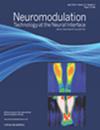Cylindrical vs Paddle Leads in Spinal Cord Stimulation for the Long-term Treatment of Chronic Pain: A Systematic Review and Meta-analysis
IF 3.2
3区 医学
Q2 CLINICAL NEUROLOGY
引用次数: 0
Abstract
Objectives
This systematic review compares the long-term efficacy of cylindrical-lead spinal cord stimulation (CL-SCS) vs paddle-lead spinal cord stimulation (Paddle-SCS) for chronic pain management.
Materials and Methods
We included prospective and retrospective studies with at least ten patients reporting on the efficacy of either lead type. Primary outcomes were pain score reduction (measured by the visual analog scale [VAS] and numeric rating scale [NRS]) and 50% pain relief after at least 12 months. Secondary outcomes included functional disability and complications, such as lead migration and infection rates. Meta-analyses compared effect sizes, while meta-regression and subgroup analyses addressed heterogeneity.
Results
A total of 96 studies, comprising 7726 patients, met the inclusion criteria. Paddle-SCS demonstrated superior pain reduction, with a standardized mean difference (SMD) of 5.37 (95% CI [5.35, 5.38]) compared with CL-SCS, which had an SMD of 4.09 (95% CI [4.08, 4.10]) on the VAS. However, CL-SCS outperformed Paddle-SCS on the NRS, with SMDs of 4.39 vs 2.35, respectively. For 50% pain relief, Paddle-SCS had a success rate of 41.4%, as opposed to 35.4% for CL-SCS. Paddle-SCS showed a lower migration rate (4.3% vs 7.2% for CL-SCS) but higher infection rates (5.0% vs 3.3%).
Conclusions
Paddle-SCS offers superior pain reduction (as measured by the VAS) and a lower migration rate, but a higher infection risk compared with CL-SCS. CL-SCS showed better outcomes as measured by the NRS. The choice between Paddle-SCS and CL-SCS should be individualized according to patient-specific factors and treatment goals. Further research with rigorous study designs is needed to provide clearer comparisons between these interventions.
用于长期治疗慢性疼痛的脊髓刺激中的圆柱形导线与桨状导线:系统回顾与元分析》。
目的:本系统性综述比较了圆柱导联脊髓刺激术(CL-SCS)与桨叶导联脊髓刺激术(Paddle-SCS)治疗慢性疼痛的长期疗效:我们纳入了至少有十名患者报告过两种导联类型疗效的前瞻性和回顾性研究。主要结果是疼痛评分降低(通过视觉模拟量表[VAS]和数字评分量表[NRS]测量)和至少 12 个月后疼痛缓解 50%。次要结果包括功能障碍和并发症,如导联移位和感染率。元分析比较了效应大小,元回归和亚组分析解决了异质性问题:共有 96 项研究符合纳入标准,其中包括 7726 名患者。与CL-SCS相比,Paddle-SCS的疼痛减轻效果更好,其标准化平均差(SMD)为5.37(95% CI [5.35,5.38]),而CL-SCS在VAS上的SMD为4.09(95% CI [4.08,4.10])。然而,CL-SCS在NRS上的表现优于Paddle-SCS,SMD分别为4.39 vs 2.35。在疼痛缓解50%的情况下,Paddle-SCS的成功率为41.4%,而CL-SCS的成功率为35.4%。Paddle-SCS 的移位率较低(4.3% 对 CL-SCS 的 7.2%),但感染率较高(5.0% 对 3.3%):结论:与CL-SCS相比,桨式SCS具有更好的镇痛效果(以VAS衡量)和更低的移位率,但感染风险更高。根据 NRS 测量,CL-SCS 的疗效更好。应根据患者的具体因素和治疗目标在桨式 SCS 和 CL-SCS 之间做出个性化选择。要对这些干预措施进行更清晰的比较,还需要进一步开展严格的研究设计。
本文章由计算机程序翻译,如有差异,请以英文原文为准。
求助全文
约1分钟内获得全文
求助全文
来源期刊

Neuromodulation
医学-临床神经学
CiteScore
6.40
自引率
3.60%
发文量
978
审稿时长
54 days
期刊介绍:
Neuromodulation: Technology at the Neural Interface is the preeminent journal in the area of neuromodulation, providing our readership with the state of the art clinical, translational, and basic science research in the field. For clinicians, engineers, scientists and members of the biotechnology industry alike, Neuromodulation provides timely and rigorously peer-reviewed articles on the technology, science, and clinical application of devices that interface with the nervous system to treat disease and improve function.
 求助内容:
求助内容: 应助结果提醒方式:
应助结果提醒方式:


